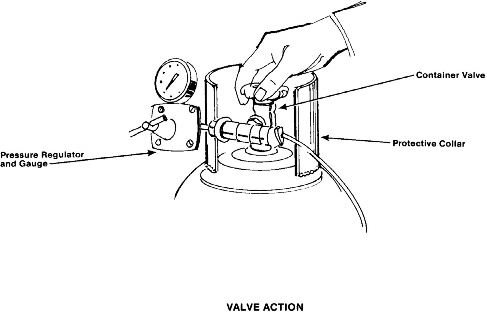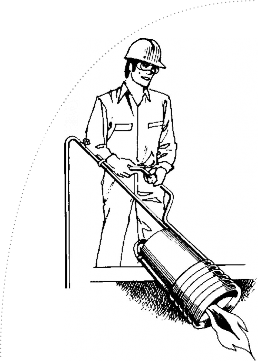- Remove the burner from the kettle or tanker.
- Have an approved spark type lighting device ready at the burner before turning on the gas.
- Open the container valve with the burner valve closed and the adjustable pressure regulator set at the minimum.
- Open the burner control valve slowly and light the gas.
- Allow vapourizer coils on liquid type kettle burners to come up to operating temperature before placing the burner into the well of the kettle or tanker.
- Place the burner back into the burner well of the kettle or tanker.
- Open the burner control valve fully. Set the adjustable regulator to the required pressure.
- Ensure that the flame is blue green in colour by adjusting the primary air control.
- To shut down the burner, turn off the container valve first. Allow the gas in the rest of the system to burn off. Then close valves or cocks at the burner.

Operating Precautions
- Regulations require that burners must not be lit unless they are at least 4.5 m (15 ft) away from 45.4 kg (100 lb) propane cylinders or 7.6 m (25 ft) away from larger propane tanks or trailer tanks.
- Once a burner has been lit, never direct it towards personnel or flammable objects. There is a dangerous invisible extension of the flame that can cause fire, considerable damage and serious injury if handled carelessly.
- Once a burner has been lit, never leave it unattended unless it is equipped with an automatic temperature controlling device.
- Burners or other flames should never be used to detect leaks in the propane system. This can result in serious fires and, under certain conditions, explosions.
- To prevent premature closure of the excess flow valve, the container valve should be opened slowly until it is fully open. If an excess flow valve closes during normal operation, close the container valve immediately. Do not use the container until the supplier has been notified and the problem rectified.
- Use only manufacturer’s parts when repairing or modifying burners. Burner orifices must never be enlarged unless recommended by the manufacturer as this can overheat the heating tubes in kettles and tankers. Overheating in turn can damage equipment, lower the quality of bitumen, and cause fires or explosions.
Hand-held Torches
Hand-held torches fuelled by smaller cylinders are used for many operations in the roofing industry, primarily heat sealing. Proper operation of this equipment involves the following precautions:
 Never use hand torches inside a building.
Never use hand torches inside a building.- Never leave lighted hand torches unattended.
- When an operation is finished, always shut off the container valve first. Allow the gas in the system to burn off, then shut off the hand torch control after the flame has gone out.
- Make sure that the fuel container is firmly braced or securely tied upright so that it cannot fall over or be knocked over.
- Be sure that a proper high-pressure hose is used to connect the torch to the pressure regulator.
- Operate the torch at the manufacturer’s recommended pressure.
- Never direct the flame from the torch onto or towards a propane cylinder.
- Always have a fully charged fire extinguisher on hand when operating heating equipment.
- The extension tube length, burner head size, and gas orifice sizes are adjustable to vary BTU ratings to meet job conditions. These changes must be undertaken by a qualified service person in accordance with the torch manufacturer guidelines and should not be undertaken by the roofer.
- In addition to the trigger, torches for LP-Gas service incorporate controls for pilot adjustment and for flame adjustment (torch control valve).
- Torches must have a stand attached to the extension tube to direct the flame away from combustibles when laid on the roof surface.
- Torches are now also available with trigger ignition capability which automatically extinguish when set down.
- Defective torches should be tagged for repair and taken out of service.
